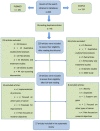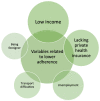Barriers to Breast Cancer-Screening Adherence in Vulnerable Populations
- PMID: 36765561
- PMCID: PMC9913751
- DOI: 10.3390/cancers15030604
Barriers to Breast Cancer-Screening Adherence in Vulnerable Populations
Abstract
Breast cancer screening through periodic mammography has been effective in decreasing mortality and reducing the impact of this disease. However, adherence to screening does not meet the desired expectations from all populations. The main objective of this review is to explore the barriers that affect adherence to breast cancer-screening programs in vulnerable populations according to race and/or ethnicity in order to propose measures to reduce the lack of adherence. We conducted a search of publications in the PubMed Central and Scopus databases. The eligible criteria for the articles were as follows: original quantitative studies appearing in SJR- and/or JCR-indexed journals from 2016 to 2021 in English or Spanish. Most of them present common barriers, such as race/ethnicity (47%), low socioeconomic (35.3%) and educational levels (29.4%), no family history of cancer and being single (29.4%), medical mistrust and a health information gap (23.5%), lack of private health insurance (17.6%) and not having annual health checks (17.6%). The target populations with the lowest adherence were Black, Asian, Hispanic and foreign women. Implementing awareness campaigns focused on these populations should be promoted, as well as working on diversity, cultural acceptance and respect with healthcare workers, in order to improve breast cancer-screening adherence worldwide.
Keywords: adherence; barriers; breast cancer screening; ethnicity; race.
Conflict of interest statement
The authors declare no conflict of interest.
Figures




Similar articles
-
Barriers to mammography screening among racial and ethnic minority women.Soc Sci Med. 2019 Oct;239:112494. doi: 10.1016/j.socscimed.2019.112494. Epub 2019 Aug 20. Soc Sci Med. 2019. PMID: 31513931 Review.
-
Screening mammography for women aged 40 to 49 years at average risk for breast cancer: an evidence-based analysis.Ont Health Technol Assess Ser. 2007;7(1):1-32. Epub 2007 Jan 1. Ont Health Technol Assess Ser. 2007. PMID: 23074501 Free PMC article.
-
Breast cancer screening adherence rates and barriers of implementation in ethnic, cultural and religious minorities: A systematic review.Mol Clin Oncol. 2021 Jul;15(1):139. doi: 10.3892/mco.2021.2301. Epub 2021 May 19. Mol Clin Oncol. 2021. PMID: 34055354 Free PMC article.
-
Beyond the black stump: rapid reviews of health research issues affecting regional, rural and remote Australia.Med J Aust. 2020 Dec;213 Suppl 11:S3-S32.e1. doi: 10.5694/mja2.50881. Med J Aust. 2020. PMID: 33314144
-
Factors that Influence Mammography Use for Breast Cancer Screening among African American Women.J Natl Med Assoc. 2020 Dec;112(6):578-592. doi: 10.1016/j.jnma.2020.05.004. Epub 2020 Jul 5. J Natl Med Assoc. 2020. PMID: 32641257 Review.
Cited by
-
From Awareness to Action: A Review of Efforts to Reduce Disparities in Breast Cancer Screening.Cureus. 2023 Jun 20;15(6):e40674. doi: 10.7759/cureus.40674. eCollection 2023 Jun. Cureus. 2023. PMID: 37485176 Free PMC article. Review.
-
Design considerations and challenges in the CHinA National CancEr Screening (CHANCES) trial and Tomosynthesis Mammographic Imaging Screening Trial (TMIST).J Natl Cancer Inst Monogr. 2025 Mar 1;2025(68):42-48. doi: 10.1093/jncimonographs/lgae049. J Natl Cancer Inst Monogr. 2025. PMID: 39989037 Free PMC article.
-
Breast Cancer Risk Assessment and Screening Practices Reported Via an Online Survey.Ann Surg Oncol. 2023 Oct;30(10):6219-6229. doi: 10.1245/s10434-023-13903-8. Epub 2023 Jul 17. Ann Surg Oncol. 2023. PMID: 37460738 Free PMC article.
-
Assessing Barriers to Breast Cancer Screening Among BIPOC Populations in the Twin Cities.J Racial Ethn Health Disparities. 2024 Dec 5. doi: 10.1007/s40615-024-02245-0. Online ahead of print. J Racial Ethn Health Disparities. 2024. PMID: 39636357
-
Breast cancer: a randomized controlled trial assessing the effect of a decision aid on mammography screening uptake: study protocol.Front Oncol. 2023 Apr 24;13:1128467. doi: 10.3389/fonc.2023.1128467. eCollection 2023. Front Oncol. 2023. PMID: 37168386 Free PMC article.
References
-
- World Health Organization. [(accessed on 26 March 2021)]. Available online: https://www.who.int/es/news-room/fact-sheets/detail/breast-cancer.
-
- GEICAM association-Breast Cancer Research. [(accessed on 15 December 2021)]. Available online: https://www.geicam.org/cancer-de-mama/el-cancer-de-mama-se-puede-preveni....
-
- SEOM (Spanish Society of Medical Oncology) Breast Cancer. [(accessed on 15 December 2021)]. Available online: https://seom.org/info-sobre-el-cancer/cancer-de-mama.
Publication types
LinkOut - more resources
Full Text Sources
Miscellaneous

